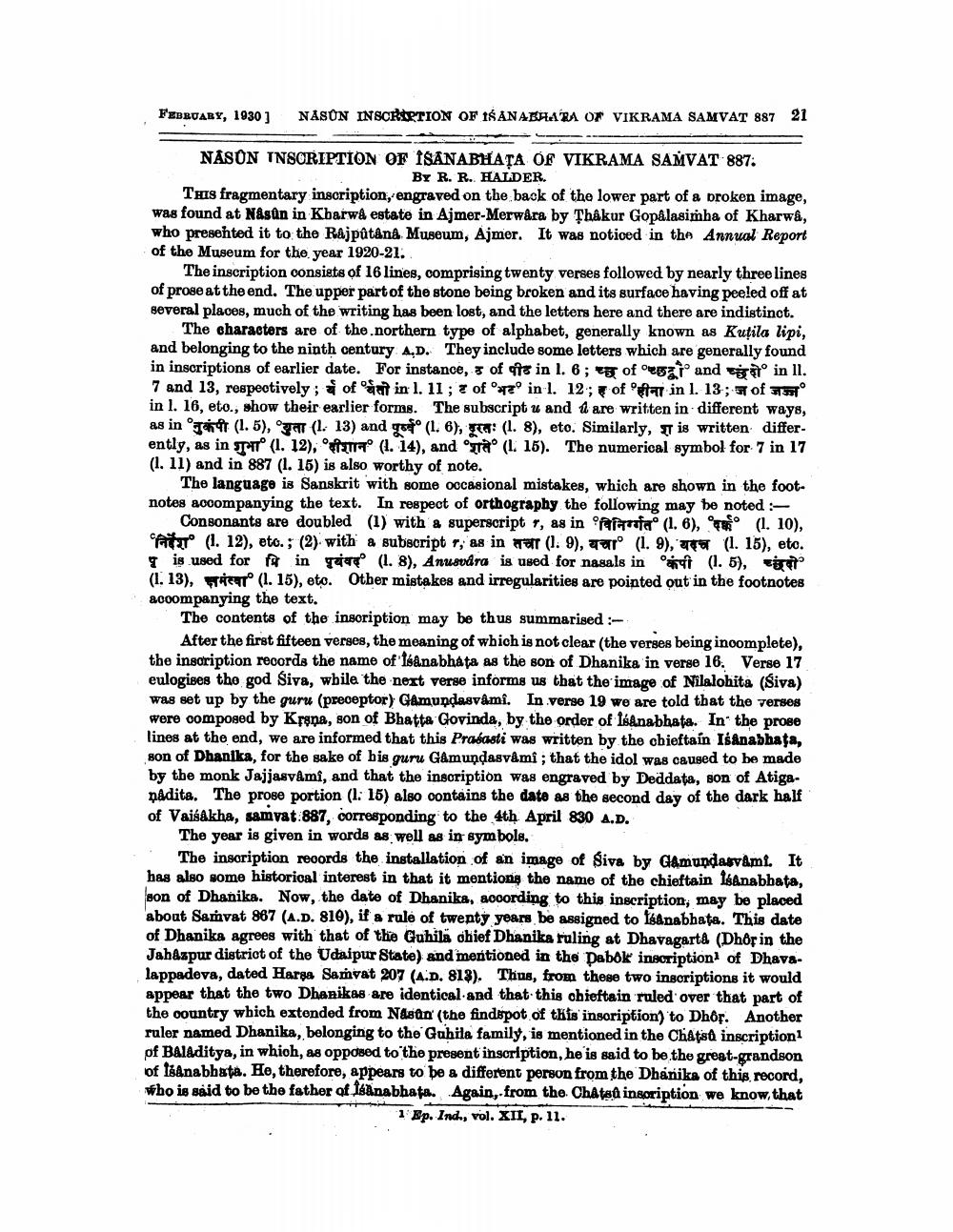________________
FEBRUARY, 1930 ]
NASUN INSCRIPTION OF IŠANABHARA OF VIKRAMA SAMVAT 887 21
NÁSON INSCRIPTION OF ISANABHATA OF VIKRAMA SAMVAT 887.
BY R. R. FALDER. This fragmentary inscription, engraved on the back of the lower part of a broken image, was found at Näsûn in Kbarwa estate in Ajmer-Merwära by Thákur Gopalasimha of Kharwa, who presented it to the Rajputana Museum, Ajmer. It was noticed in the Annual Report of the Museum for the year 1920-21.
The inscription consists of 16 lines, comprising twenty verses followed by nearly three lines of prose at the end. The upper part of the stone being broken and its surface having peeled off at several places, much of the writing has been lost, and the letters here and there are indistinct.
The characters are of the northern type of alphabet, generally known as Kuțila lipi, and belonging to the ninth century A.D. They include some letters which are generally found in inscriptions of earlier date. For instance, of gte in l. 6;ug of egzto and to in II. 7 and 13, respeotively; of in 1. 11 ; 2 of 2° in l. 12; 7 oftar in l. 13; of 1 in l. 16, eto., show their earlier forms. The subscript u and I are written in different ways, as in #4 (1.5), gat (1. 13) and goto (1.6), y: (1. 8), eto. Similarly, T is written differently, as in TTT (1. 12), (1. 14), and trao (1. 15). The numerical symbol for 7 in 17 (1. 11) and in 887 (1. 15) is also worthy of note.
The language is Sanskrit with some occasional mistakes, which are shown in the footnotes accompanying the text. In respect of orthography the following may be noted
Consonants are doubled (1) with a superscript , as in partao (1.6), (1. 10), "Patto (1. 12), eto. ; (2) with a subscript t, as in Ter (1.9), Taro (1.9), 2 (1. 15), eto. is used for in iTY (1.8), Anusvára is used for nasals in
(1. 5), to (1.13), WASHT° (1. 15), eto. Other mistakes and irregularities are pointed out in the footnotes acoompanying the text.
The contents of the insoription may be thus summarised :
After the first fifteen verges, the meaning of which is not clear the verses being inoomplete), the inscription records the name of Isanabhata as the son of Dhanika in verse 16. Verse 17 eulogises the god Siva, wbile the next verse informs us that the image of Nilalohita (Śiva) was set up by the guru (preceptor) Gamundasvami. In verse 19 we are told that the verses were composed by Krona, son of Bhatta Govinda, by the order of Isanabhata. In the prose lines at the end, we are informed that this Prasasti was written by the chieftain Isanabhata, son of Dhanika, for the sake of bis guru Gámundasvami; that the idol was caused to be made by the monk Jajjasvami, and that the inscription was engraved by Deddata, son of Atiganadita. The prose portion (1: 15) also contains the date as the second day of the dark half of Vaisakha, samvat:887, corresponding to the 4th April 830 A.D.
The year is given in words as well as in symbols.
The inscription records the installation of an image of Siva by Gámundasvämt. It has also some historioal interest in that it mentions the name of the chieftain Isanabhata, son of Dhanika. Now, the date of Dhanika, according to this inscription; may be placed about Samvat 887 (A.D. 810), if a rule of twenty years be assigned to fsanabhata. This date of Dhanika agrees with that of the Guhila chief Dhanika ruling at Dhavagarta (Dhör in the Jahazpur district of the Udaipur State) and mentioned in the Dabok inscription of Dhavslappadeva, dated Harga Samvat 207 (A.D. 813). Thus, from these two inscriptions it would appear that the two Dhanikas are identical and that this chieftain ruled over that part of the country which extended from Nastat (the findspot of this insoription) to Dhof. Another ruler named Dhanika, belonging to the Guhila family, is mentioned in the Chatså inscription1 of BalAditya, in which, as opposed to the present inscription, he is said to be the great-grandson of I&Anabbgta. He, therefore, appears to be a different person from the Dhanika of this record, Who is said to be the father of Isanabhata. Again, from the Chats insoription we know that
1 Ep. Inch, vol. XII, p. 11.




